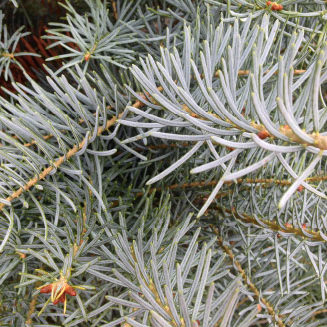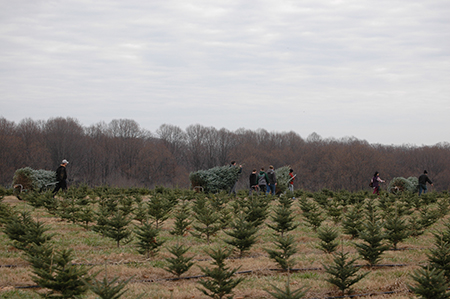
Common Characteristics:
These small, narrow needles are around 1 – 1 ½ in. in length and occur in rows. They have good foliage color, good needle retention, and a pleasing shape and aroma.
Description:
White fir, also commonly called concolor fir, is native to the western United States and may reach sizes of 130-150 ft. in height and 3 to 4 ft. in diameter. The oldest white firs may occasionally reach 350 years of age. It produces a spire-like crown with a straight trunk.
On older trees, the lower one-half to one-third of the crown is often free of branches.
Leaves (needles) are small and narrow and occur in rows. On upper branches, needles tend to be thicker and more curved than those on lower branches. Needles are usually 1/2 to 1 1/2 inch long, pointed or notched at the tip, bluish-green when young turning dull green with age. Typically, they are flat, without stalks.
The bark on younger trees is thin, smooth, gray with numerous resin-bearing pockets. Older bark is thicker, reddish-brown to light gray and broken into irregular, flattened scales.
Both male and female flowers (strobili) are found on the same tree. Pollination occurs in the spring and cones mature in one season. Cones are barrel-shaped, about 3 to 6 inches long, and mature in early fall. Cones are upright and generally disintegrate after seeds are shed. Good seed crops occur at 2- to 4-year intervals.
White fir is tolerant of a considerable amount of shade. Its best growth is on moist loamy soils, but may often be found on dry, thin soils. The species seldom occurs in pure stands but grows in association with numerous other species depending on location and elevation. White fir is commonly found with Douglas-fir, sugar pine, ponderosa pine, and red fir. White fir is severely damaged by mistletoe. Leaves of white fir are often attacked by spruce budworm and Douglas-fir tussock moth. Bark beetles may also be a serious problem in some areas. As a Christmas tree, white fir has good foliage color, a pleasing natural shape and aroma, and good needle retention.
Details of this tree species provided by National Christmas Tree Association

Caring for your tree
Thank you for purchasing a Christmas Tree at Pine Valley Farms. You may have noticed dead needles inside the tree.
Evergreen trees shed their inside needles every fall and sometimes needles lodge among the branches.
This is a normal process and not the sign of a old tree.
To keep your tree fresh as possible, we recommend the following care.
1. Cover your tree for the ride home.
2. Once the tree is home, make a fresh , straight cut across the trunk about an inch from the original cut.
This opens the tree stem so it can take up water. Then plunge the trunk end immediately into fresh water.
If the water level drops below the fresh cut, a seal will form and a new cut will be necessary.
3. Trees are thirsty. They may drink between two pints and a gallon of water per day.
